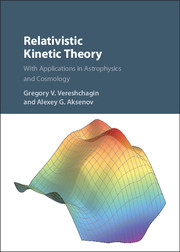Book contents
- Frontmatter
- Contents
- Preface
- Acknowledgments
- Acronyms and Definitions
- Introduction
- Part I Theoretical Foundations
- Part II Numerical Methods
- Part III Applications
- 10 Wave Dispersion in Relativistic Plasma
- 11 Thermalization in Relativistic Plasma
- 12 Kinetics of Particles in Strong Fields
- 13 Compton Scattering in Astrophysics and Cosmology
- 14 Self-Gravitating Systems
- 15 Neutrinos, Gravitational Collapse, and Supernovae
- Appendix A Hydrodynamic Equations in Orthogonal Curvilinear Coordinates
- Appendix B Collision Integrals in Electron-Positron Plasma
- Appendix C Collision Integrals for Weak Interactions
- Bibliography
- Index
15 - Neutrinos, Gravitational Collapse, and Supernovae
from Part III - Applications
Published online by Cambridge University Press: 09 March 2017
- Frontmatter
- Contents
- Preface
- Acknowledgments
- Acronyms and Definitions
- Introduction
- Part I Theoretical Foundations
- Part II Numerical Methods
- Part III Applications
- 10 Wave Dispersion in Relativistic Plasma
- 11 Thermalization in Relativistic Plasma
- 12 Kinetics of Particles in Strong Fields
- 13 Compton Scattering in Astrophysics and Cosmology
- 14 Self-Gravitating Systems
- 15 Neutrinos, Gravitational Collapse, and Supernovae
- Appendix A Hydrodynamic Equations in Orthogonal Curvilinear Coordinates
- Appendix B Collision Integrals in Electron-Positron Plasma
- Appendix C Collision Integrals for Weak Interactions
- Bibliography
- Index
Summary
Most energy generated in the gravitational collapse to a supernova is radiated in neutrinos, hence the role of these particles in a supernova explosion is crucial. Current models of core collapse supernovae focus on multidimensional hydrodynamics and nuclear burning and treat neutrino transport in a simplified manner. In this last chapter an example of accurate neutrino treatment in a spherically symmetric collapse is given. The role of multidimensional effects is discussed. These results are of interest for the multidimensional models with large-scale convection as well as for the ongoing experimental search for neutrinos from supernovae.
Supernova Models and Neutrinos
Supernovae (SNe) are produced by stars that end their late evolution in a catastrophic explosive process. The name supernova was introduced and the difference between SNe and novae in terms of their estimated explosive powers was described in [515]. The luminosity of a SN at its maximum, which lasts for several days, is comparable to the total luminosity of its host galaxy. It was first hypothesized in [516] that SN explosions should be accompanied by the formation of neutron stars; the neutron had been discovered just two years earlier. The total energy involved into explosion is approximately 1053 erg, mostly released in the form of neutrinos. Approximately 1% of this energy, namely, 1051 erg, is released in the form of kinetic energy of the SN ejecta. Only approximately 1% of that kinetic energy, i.e., 1049 erg, is emitted in the form of photons, which are detected as the SN event [517, 518]. The relevant timescales are as follows: collapse of the core occurs on a ≤ 0.1 s timescale, the SW propagation inside the collapsing core takes ~10 ms, and the neutrino cooling time of the hot neutron star is 10 s.
There are two general types of a SN, classified according to the presence of hydrogen absorption lines in observed spectra. Absorption lines are present in the spectra of Type II SNe and absent in the spectra of Type I SNe. In addition, Type II SNe normally contain compact remnants, although such a remnant was not found in the nearby SN 1987A [519]. In this chapter,mainly Type II SNe, or core-collapse SNe, are discussed.
- Type
- Chapter
- Information
- Relativistic Kinetic TheoryWith Applications in Astrophysics and Cosmology, pp. 262 - 277Publisher: Cambridge University PressPrint publication year: 2017



